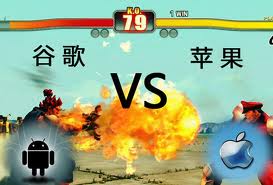 在先前的文章中我提到过由于苹果自上而下和以设计师为中心的产品生产流程使得苹果能够设计出更好的用户界面。但是这却在升级网络服务时成为掣肘。在这方面,谷歌的自下而上和engeneer-driven的组织结构模式更有优势。
在先前的文章中我提到过由于苹果自上而下和以设计师为中心的产品生产流程使得苹果能够设计出更好的用户界面。但是这却在升级网络服务时成为掣肘。在这方面,谷歌的自下而上和engeneer-driven的组织结构模式更有优势。
理解这些最好的办法就是把运算平台看成是一个漏斗。在漏斗的下方是用户有限的信息接收能力。而漏斗的的上端则是广阔的大千世界---网站,设备,人,组织和其他的实体,用户就是通过这些渠道去获取信息的。运算平台的任务就是把漏斗的两端联系起来---把外界鱼龙混杂的信息过滤,重新组织,直到达到用户可以消化吸收的程度。
谷歌和苹果的出发点一个是漏斗的上方,一个是下方。这一点可以在他们所开发的操作系统上看出来。苹果从用户的角度出发,将用户界面设计的尽可能简单而又不失新意。为了达到这一目标,苹果公司严格控制技术。因为iPhone,iOS,the iTunes Store,Mac OS X和iCloud都是苹果公司的产品,他们之间都有着良好的互通性。
相反,谷歌比较注重广阔的外部世界。谷歌公司一直致力于如何使安卓系统能够更好的处理外界信息。苹果在开发自己的硬件的时候,谷歌却终止了和许多家硬件制造商的合作。苹果与美国电话电报公司达成排他性协议,控制用户体验,但是谷歌却提供自由的许可条款,为的是让所有的无线运营商都能获得信息,谷歌不仅有更自由的应用商店的规则,它还允许第三方来开设他们自己的应用商店,就像埃里克·施密特说的那样:“苹果拒绝了,但是我们可以接受。”
这个办法的确是有缺点的。就像我之前说过的,安卓的用户体验不如iPhone。糟糕的是谷歌允许他的伙伴可以根据客户要求随意定制安卓系统。这无异于雪上加霜。相似的是,各种各样的硬件配置使得软件开发变得极为复杂。因为,软件开发人员没办法预想硬件会支持哪些功能。
说的抽象一些,就是谷歌把精力放在海量的信息上,而用户就会受损。与第三方沟通的代价就是安卓有时会被迫提供一些半熟的功能。许多的功能只是适用于iphone,比如音乐同步收听,邮件客户端组态,但安卓用户也要求这些。
苹果则是有相反的烦恼。为了给用户提供成熟的功能,苹果一直控制整个技术流程。这样一来虽然用户界面简单而又新奇,但是这使得与第三方的交互变得更加困难。换句话说,苹果公司过于看重用户而忽略了宽广的信息渠道。
I’ve argued before that Apple is good at producing great user interfaces thanks to its top-down, designer-centric product development process. But that approachbecomes a liability for building scalable network services. For those kinds of tasks, Google’s bottom-up, engineer-driven organizational structure works better.
A good way to visualize this is by thinking of a computing platform as a funnel. At the narrow end of the funnel is a human user with an extremely limited capacity for absorbing information. At the fat end of the funnel is “the world”—the collection of websites, devices, people, organizations, or other entities with which the user might wish to exchange information. The job of a computing platform is to connect the two—to filter and organize the vast amounts of information at the fat end of the funnel into a form that is digestible by the user at the skinny end.
Google and Apple like to start from opposite ends of the funnel, and this tendency is reflected in the mobile OSes they’ve built. Apple starts with the skinny end of the funnel, making the user interface as simple and intuitive as possible. They do this by tightly controlling as much of the technology “stack” as possible. Because iPhone, iOS, the iTunes Store, Mac OS X, and iCloud are all made by the same company, they offer unparalleled polish and effortless interoperability.
Google, in contrast, focuses on the wide end of the funnel. The company has focused on making Android work gracefully with as much of the “real world” as possible. When Apple was building its own hardware, Google was cutting deals with numerous hardware manufacturers. While Apple was negotiating an exclusive deal with AT&T that gave Cupertino control over the user experience, Google offered liberal licensing terms in an effort to get all wireless carriers on board. Google is not only has more liberal app store rules, it also allows third parties to develop app stores of their own. As Eric Schmidtput it last year: “If they say no, we say yes.”
This approach has real disadvantages. As I written before, the Android user experience isn’t as good as the iPhone experience. Google’s version of Android is less polished than iOS, and the problem is exacerbated by the fact that Google has allowed its partners to customize the versions of Android they sell, which tends to make it worse. Similarly, the wide variety of hardware configurations makes it more complicated to develop software for the platform, since developers can’t make as many assumptions about what features the hardware will support.
Put more abstractly, Google’s focus on the fat end of the funnel means that the narrow end—the user experience—suffers. The price of interoperating with a wide variety of third parties is that Android is sometimes forced to present its users with features that feel “half baked.” Many of the features that “just work” on the iPhone, like music syncing and mail client configuration, require babysitting by Android users.
Apple has the opposite problem. In its quest to avoid ever subjecting an iPhone user to features that feel half baked, Apple insists on maintaining control over the entire technology stack. That produces simple, intuitive user interfaces, but it makes it harder to interoperate with third parties who may not be willing to cede control to Apple. In other words, Apple’s obsessive focus on the narrow end of the funnel limits how wide the wide end of the funnel can be.
 在先前的文章中我提到过由于苹果自上而下和以设计师为中心的产品生产流程使得苹果能够设计出更好的用户界面。但是这却在升级网络服务时成为掣肘。在这方面,谷歌的自下而上和engeneer-driven的组织结构模式更有优势。
在先前的文章中我提到过由于苹果自上而下和以设计师为中心的产品生产流程使得苹果能够设计出更好的用户界面。但是这却在升级网络服务时成为掣肘。在这方面,谷歌的自下而上和engeneer-driven的组织结构模式更有优势。
